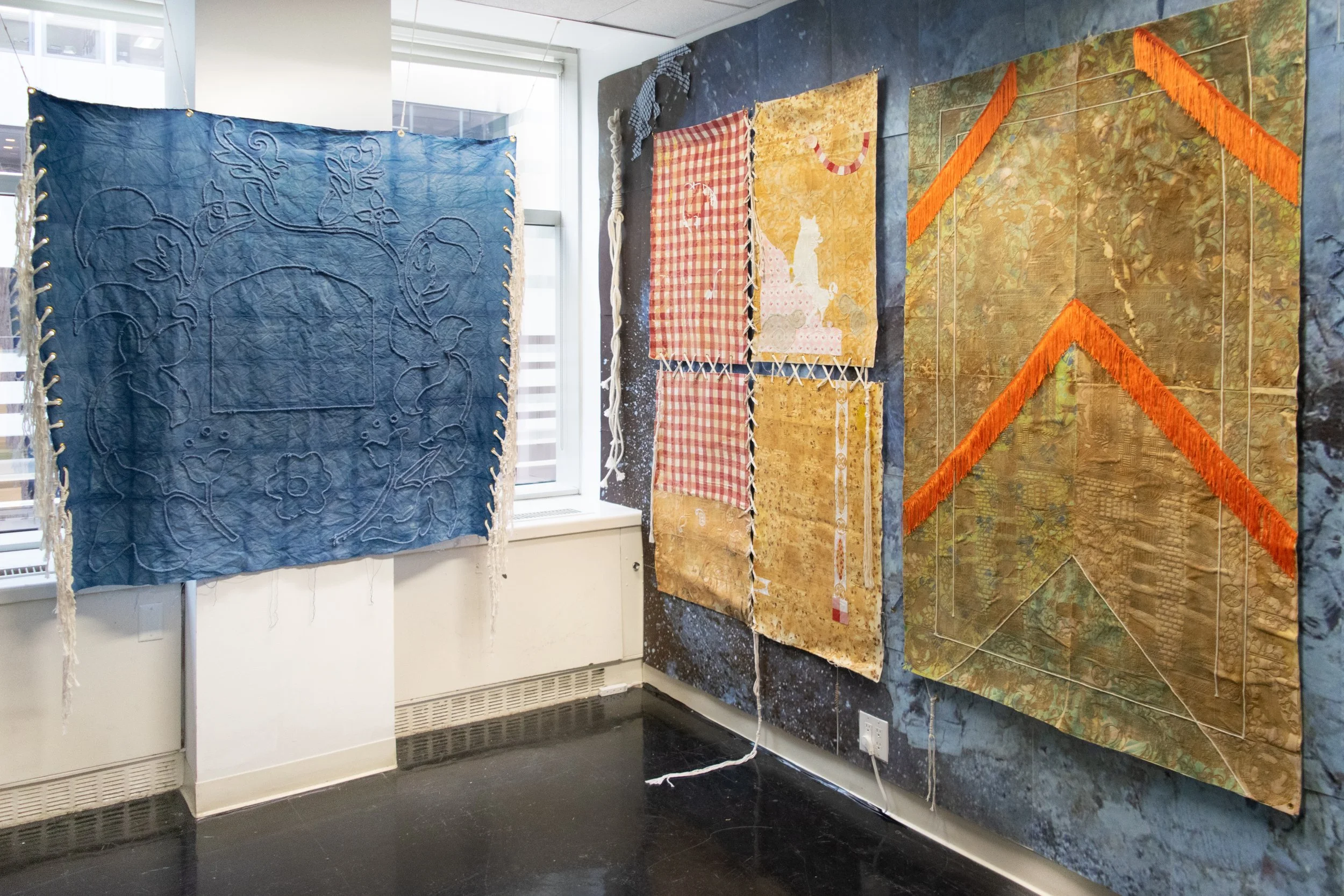Curtain of Blue
Francesca Pessarelli presents artist Ben Blaustein’s work in Curtain of Blue. This presentation is an ode to the fraught experience of Blaustein’s upbringing in Jewish-American culture, layering together coming of age memories with the rich symbolism and ritual of Judaic tradition. Blaustein’s work relishes the friction between religious dogma and secular adolescence, ascribing divinity to the heretic and unorthodox as indispensable to the survival of Jewish history.
Ben Blaustein’s practice centers around the all-encompassing cultural and spiritual phenomenon that is growing up within the Jewish-American community, which is marked by the continuous spinning, breaking, and repair of a thread which goes back millennia. This thread plays a formative role in Blaustein’s work, appearing in various forms, notably Tzitzit—threads which hang off the corners of Jewish prayer shawls (Tallis)—which frame, pull, and bind together panels of imagery and fabric. Together, these panels form delicately rendered, tapestry-like cloths named Mizrah (meaning east), after the wall plaques in homes of the western Jewish diaspora indicating the proper direction of prayer. These Mizrahs incorporate laser cut fabrics from Blaustein’s childhood home as well as allusions to images from their medieval counterparts. Leopards, eagles, deer, and lions all make appearances as they reference commandments of virtues from the Torah— "Be bold as a leopard, light as an eagle, swift as a deer, and strong as a lion, to do the will of your Father who is in Heaven”. The laser engraving is also a way in which Blaustein engages with the flame, which is historically a symbol for destruction, renewal, and the ultimate survival of the Jewish community.
Also incorporated in these works are subtle references to the Torah’s meticulous instructions for the construction of the tabernacle, a portable sanctuary originating from the Israelites’ exodus from Egypt and resulting forty years in the desert. These instructions, which include the incorporation of fifty gold loops, curtains of blue, purple, and crimson, and finely twisted linen all make appearances in Blaustein’s work. Gold hoops, large swaths of blue cloth, images rendered in twisted ropes all contain but do not quite conform to the Torah’s prescription.
What appears initially to be reverent interpretations of these ancient symbols of Jewish tradition slowly reveal themselves instead as subtle subversions—not only of the divinity of the objects but also their deep ties to institutions and symbols of wealth and power—particularly in the materials used, which are either undeniably secular or seditiously secularized. Brass grommets stand in for gold loops. Store bought blue dye replaces the precious indigo that was once believed to have originated from the mythical Chilazon and subsequently used exclusively by royalty. Deconstructed mop heads and twine rather than fine linen form both the Tzitzit and the tapestry-like images in works such as Water Tower (1809). The aim is not necessarily to tear down or trivialize but rather to democratize and domesticate. To bring to the every day the all-consuming sensation of the infinite and divine, to see the sacred in even the smallest, most insignificant things.
Odes to the quotidian experiences of Jewish-American adolescence are also lovingly woven into every one of Blaustein’s works. From scenes of Jewish camp summers to photos of the people and places he grew up around, Blaustein establishes his practice as indubitably personal. It is in these moments of daily life that the thread passed generationally through time is both most precious and most precarious. Irreverent tales of skinny dipping at camp, secret bacchanals in the woods, and hours of gossiping about anything and everything all make appearances as flashes of memories and abstracted scenes of suburbia—phone lines, pools, lighthouses—layered with the creatures of medieval virtues. But what can instinctually be interpreted as heresy, tension, or a weathering of the thread, on further examination reveal themselves to be invaluable, almost sacred moments of participation. Swims with friends under the thick curtain of night are cleansing baths. Joyous gatherings away from the judicious parental gaze recall ancient clandestine religious services. And petty gossip is really just an indulgent but indispensable passing of oral histories and human connection. Each dalliance, each murmured story strengthens the thread and pulls together the void of time like a drawstring.
Ben Blaustein (b.1998, Boston MA) is a New York based artist currently pursuing a BFA at the Cooper Union for the Advancement of Art And Science. Identifying as part of what Stephen J. Whitfield describes as the post-Jewish generation, Blaustein’s work focuses on balancing his personal experience as a Jewish-American adolescent with the larger cultural memory and inscribed traditions of the broader Jewish community. Through both imagery and materiality, his work considers the re-contextualization of traditional Jewish motifs and customs in order to more accurately represent his own concept of Divinity. Images of the natural world populate his compositions, working simultaneously with depictions of sublimity and immanence and as stand-ins for traditional ideas of god. Blaustein was invited to participate in the Arts on Site Residency program as well as the Jewish Museum Virtual Summer Institute in 2021.
Francesca Pessarelli, May 2021





